The mystery of the operation "Cottage"
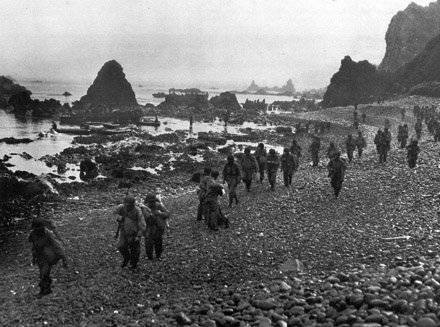
On June 3, 1942 of Japanese aircraft 56 launched from the aircraft carriers "Ryudze" and "Zunier" and headed for the American base on the Aleutian Islands of Dutch Harbor. The raid was sudden for the Americans. However, the second Pearl Harbor did not work. First, because of the bad weather, only 13 bombers and 6 fighters reached the target. Secondly, there were no worthy targets in the harbor of Dutch Harbor. There were only a couple of destroyers and small ships. Japanese bombers picked the largest ship and bombed it. But, alas, it turned out to be the Norsvern tank camp, adopted by the Japanese as a cruiser.
The next day, the Japanese repeated the raid. A total of 43 American soldiers were wounded in Dutch Harbor and 50 was wounded, a seaplane hangar, two barracks and four large oil tanks were destroyed. The Japanese lost 7 aircraft, the Americans - 8. As you can see, the results of the raid were more than modest, compared with Pearl Harbor, where the US 8 battleships were destroyed or damaged. Nevertheless, the Japanese managed to land in Dutch Harbor.
On June 6 Japanese ships landed a battalion of marines consisting of 550 people and 700 workers on Kyska Island. Kyska Island (Kiska), like the rest of the Aleutian Islands, belonged to Russia from the middle of the 18th century to 1861, and then, together with Alaska, was sold to Alexander II to America. Kyska Island is located approximately 1500 km from the coast of Alaska, 1080 km from Dutch Harbor, 500 km from the Commander Islands (USSR) and 1000 km from Kamchatka.
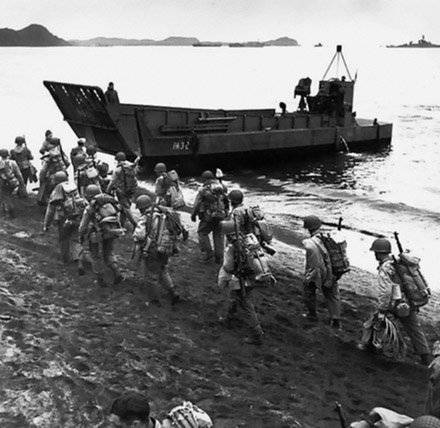
On June 7, the Japanese landed an army infantry battalion and a detachment of builders on Attu island, about 300 km east of Kyski. There was no US armed forces on the islands, and the American command found out about Japanese occupation of Kyski and Attu only after 5 days.
Why did the Japanese need the Aleutian Islands? To answer this question, we must dispel one of the myths of the Second World War - Japan’s aggressive designs with respect to the United States. Naturally, the Japanese samurai were not angels, and they dreamed of occupying the whole of China, the Soviet Far East, the countries of Indonesia, etc. But in relation to the US, Japan adhered to a strictly defensive policy. War with Japan provoked the rulers of the United States. It would seem that the United States was profitable to compromise with the Japanese and throw all forces into the struggle against Nazi Germany. But the leadership of the United States talked a lot, but thought little about the war with Hitler. It was to his advantage that Germany, Italy, the USSR and Britain mutually exhausted themselves in the war, and, on the other hand, the US bankers were not at all satisfied with neutral Japan retaining its position in Asia by the end of the war. Therefore, at the end of 1940 - the beginning of 1941, the United States and Britain organized the oil blockade of Japan. Oil production in Japan met the needs of the country only 10%. By December 1941, Japan’s oil reserves remained only for 6 months, then the economic and military disaster of the Land of the Rising Sun was predicted. So Japan was forced to go to war.
The Japanese defeated the US Navy at Pearl Harbor and captured the Philippines, Malaya and Indonesia. Now the Japanese had oil, and they deliberately switched to defense, because they were not interested in the continuation of the war. The Japanese planned to create a “Japanese defense belt,” which included the islands of Indonesia, New Caledonia, Fiji, Samoa, Midway Atoll and the western Aleutian Islands.
In early June, 1942, the Japanese decided to synchronously land assault forces on the islands of Midway, Kyska and Attu. The last two islands, as we know, were captured without loss. But on Midway Island, the Americans managed to sink four of the five Japanese aircraft carriers and destroy the 253 aircraft, while American losses made up the 1 aircraft carrier and 150 aircraft. The sinking of Japanese aircraft carriers was a turning point in the war in the Pacific. The Japanese made a big strategic mistake by sending two aircraft carriers to Dutch Harbor. The appearance of Ryudze and Dzunier near Midway Island could turn defeat into victory, since most of the American aircraft on the two surviving aircraft carriers were damaged and the pilots were exhausted in battle.
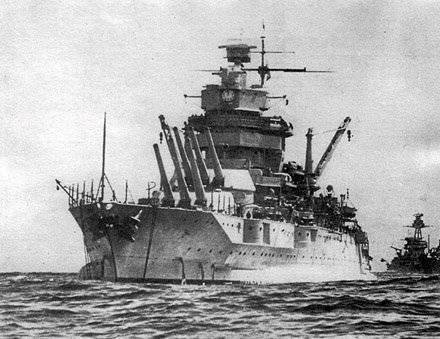
The Japanese government hid from its own population the fact of the death of the four best aircraft carriers. Crews from sunk ships were isolated for a time. But on the seizure of the islands Kyska and Attu Japanese propaganda trumpeted not only in Japan but also in the whole world. In fact, the occupation of these islands was an absolutely senseless undertaking, since nature itself did not allow creating bases for any serious operations against Japan there. But ordinary people who are not familiar with either military strategy or geography, the Japanese flag on American territory could not fail to impress.
What is the most funny - the government and top management of the USA bought into Japanese propaganda. President Roosevelt ordered that the Japanese be beaten out of American territory at any price.
To fight the two battalions of the Japanese, who had neither ships nor aviation, the American command transferred the 11th air army to the Aleutian Islands. The fleet sent there three battleships, an aircraft carrier, 8 cruisers, 21 destroyers and about a dozen submarines, as well as a fourth naval aviation wing (wheeled shore-based aircraft and flying boats). American soldiers are brave guys, ten of them could easily overwhelm one Japanese.
Since February, 1943 began the continuous bombardment of the islands of Kyska and Attu. 10 May 1943 The American amphibious assault made up of Attu Island as part of the battleships Pennsylvania, Nevada, Idaho, the aircraft carrier Nassau, seven cruisers, 19 destroyers and 44 amphibious assault, patrol and other ships. 15 of thousands of US marines and US soldiers were landed on the beach. On the island of Attu, at the time of the landing, there was a 303 th separate infantry battalion under the command of Lieutenant Colonel Yamazaki and a detachment of civilian builders, about 2000 in all. Fighting on the island lasted until May 30. The Japanese were dead. The Americans succeeded in capturing all 28 soldiers and workers. The rest preferred death. The Americans lost 552 people killed and 1140 wounded.
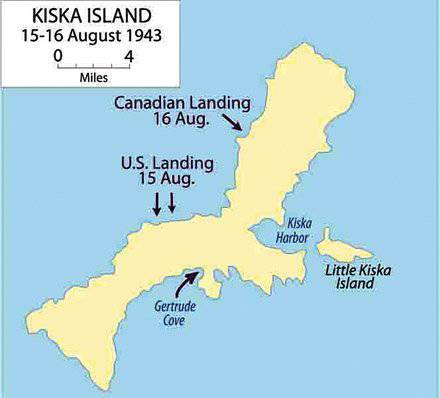
The fierce resistance of the Japanese to Atta puzzled American generals and admirals. By landing on the island of Kyska, where there were over 5 thousands of Japanese, they decided to go more seriously. For a start, three more battleships were called up from the USA - New Mexico, Mississippi and Tennessee, three heavy cruisers and a dozen destroyers. In terms of combat power, the American squadron, pulled down to 1943 by the summer to the Aleutian Islands, far exceeded the entire Soviet, German or Italian fleets. The invasion army consisted of 30 thousands of American soldiers and 5 thousands of Canadians. The landing operation was given the code name "Cottage".
From the middle of July 1943, the airplanes of the 11 Air Army and naval aviation bombarded Kyska Island almost daily.
Americans still keep secret the details of the operation on the island of Kyska. But it is known that during the battles for the islands of Atta and Kysk, the 11-I air army dropped more than 4 thousand tons of bombs on the islands. It was lost: from anti-aircraft fire of the Japanese - 41 aircraft, as a result of operational losses (due to bad weather conditions) - 184 aircraft; total lost xnumx machines. In addition, several dozen cars lost coastal and aircraft carrier naval aviation. The exact number of knocked down cars closed by the Americans. It is only known that in May 225 from the aircraft carrier Nassau made 1943 sorties for attacks on the island of Attu and lost 86 machines.
Kyska Island was constantly bombarded by American ships. Here, for example, only 2-August on Kysk released 120 – 356-mm, 200 – 203-mm, 600 – 152-mm and 1400 – 127-mm shells. In the following 13 days, 10 similar shelling occurred.
At dawn 15 August 1943, an American squadron approached the island of Kyska, which included over 100 ships. In the air hung hundreds of aircraft. Under the cover of thirty-six 356-mm guns from three battleships and hundreds of 203 – 127 mm guns, 35-thousandth troops were landed on the other ships on the shore. Before the front of the attackers, a barrage of fire raged up, created by aviation and naval artillery. The first two days, the offensive of the American and Canadian troops proceeded as planned. There were very few killed and wounded paratroopers - a few dozen. There were no casualties on the ships, except that on the night from 17 to 18 of August, the latest destroyer Abner Reed with a displacement of 2050 T was blown up by a mine. The destroyer split in half, but the nose remained afloat and was towed to shore. The 71 man died and the 34 man was injured.
On the third day of the battle for Kyska, the irreparable happened. Vice-Admiral Kincaid and Major-General Korlett, with their pale faces commanding the operation, were approached by staff officers and reported the terrible news... Maybe with a cry of "Banzai!" Suicide bombers went on the attack, or the Japanese used a secret weapon? Alas, everything turned out to be much simpler - there were no Japanese in Kysk at all. It turns out that for three weeks the Americans and the five thousand Canadians who joined them fought against an imaginary opponent. And the loss of the assault on the two days of the Kyski assault was partly due to anti-personnel mines left by the Japanese, but mainly due to the impact of their own aircraft and artillery.
What expressions were on the faces of the gentlemen Kincaid and Corlett, it is not known for certain, but you can imagine them, recalling the face of Louis XV in the film “Fanfan-Tulip”: “Who stole our opponent?”
In fact, everything was very simple. The Japanese monitored the weather around Kyska island all July. 21 July island shrouded in continuous fog. The next day, the naval base Kashivabara (Paramushir Island) left the operational connection of Japanese ships consisting of two light cruisers and 14 destroyers. On July 29, both cruisers and 10 destroyers entered the harbor of Kyska Island, while 4 destroyers remained on patrol. The Japanese ships came in fog, focusing on 21 type radars installed on the Kiso and Abukuma cruisers, as well as on direction finding radars from the island. In the harbor, the ships anchored in the 13 hour. 50 min., And already in 14 hour. 35 min. removed from the anchor, taking on the 5183 man, that is, the entire garrison of the island.
On July 31, all Japanese ships returned to the base of Kasivabara, where they unloaded the garrison of Kyska Island. As an armada of American ships and airplanes, which at that time had sufficiently sophisticated radar stations, managed not to notice the Japanese, the Americans themselves still cannot explain.
The “Battle for Kyska Island” was a one-of-a-kind battle in the world stories. The “absence of absence” of the Japanese in Kysk during the war years was concealed. And after the war, this was briefly and unclearly mentioned in the writings of military historians.
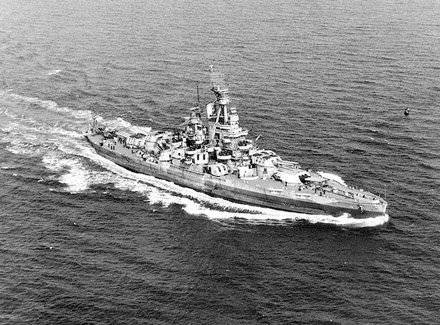
PS In the story about Kyska there is also a curious moment that was not noticed by anyone. As already mentioned, the Japanese ships that evacuated the garrison went to sea on July 22, 1943 from the Kashiwabara base, which was located on Paramushir Island, about 33 km from the southern coast of Kamchatka. Thus, Japanese ships could be seen with the naked eye from Soviet territory. Moreover, they walked in the reach of the 130-mm guns of our coastal battery No. 382 at Cape Lopatka. I'm not talking about patrol aircraft, Pacific patrol ships fleet and the NKVD, as well as numerous fishing trawlers. It is clear that the Soviet command knew about the withdrawal of the Japanese squadron, its composition and course. There was no war with the Japanese, and it was impossible to attack them, but could they inform the allies? Moreover, there was a large flow of cargo through Kamchatka through Lend-Lease, and almost daily aircraft flew from Alaska and to Alaska. No, it’s not in vain that the archives of the Great Patriotic War are still classified.
Information